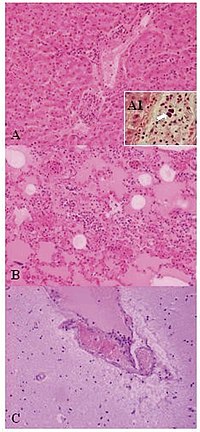
Photo from wikipedia
Since high proportions of aroma-relevant molecules in plant-derived juices are present in glycosylated forms, the introduction of glycosidase activity during processing is an important tool to modify the aroma composition… Click to show full abstract
Since high proportions of aroma-relevant molecules in plant-derived juices are present in glycosylated forms, the introduction of glycosidase activity during processing is an important tool to modify the aroma composition of the product. During winemaking, the addition of β-glycosidase enzyme or microorganisms with β-glycosidase activity is an established technology. However, low stability under acidic conditions and low selectivity for hydrolysis of different glycosides are still drawbacks, which limit application possibilities. Here, we report the identification and characterization of non-Saccharomyces yeast strains with relatively high β-glycosidase activity in their cultures. We found strong indications for intracellular localization of the enzymes, which is in line with the pH robustness found in experiments with whole cells. Furthermore, we compared the selectivity of aroma compound release from glycoside mixtures using whole cells or cell extracts. The results showed strong differences for the released aroma patterns, which indicates the transport of glycosides and intracellular hydrolysis. Our work demonstrates the application potential of yeasts with intracellular β-glycosidase activities as catalysts with high pH robustness and selective aroma release properties. PRACTICAL APPLICATION: The yeast strains identified and characterized within this work can be applied in wine processing but also in other processes to release aroma molecules from their glycosylated precursors provided by the plants. The strains show relatively high activity of the relevant enzyme, β-glycosidase, also at low pH, which is essential in many processes. In contrast to most other approaches, the enzyme is inside the cells, which can lead to a specific release of certain aroma compounds.
Journal Title: Journal of food science
Year Published: 2022
Link to full text (if available)
Share on Social Media: Sign Up to like & get
recommendations!